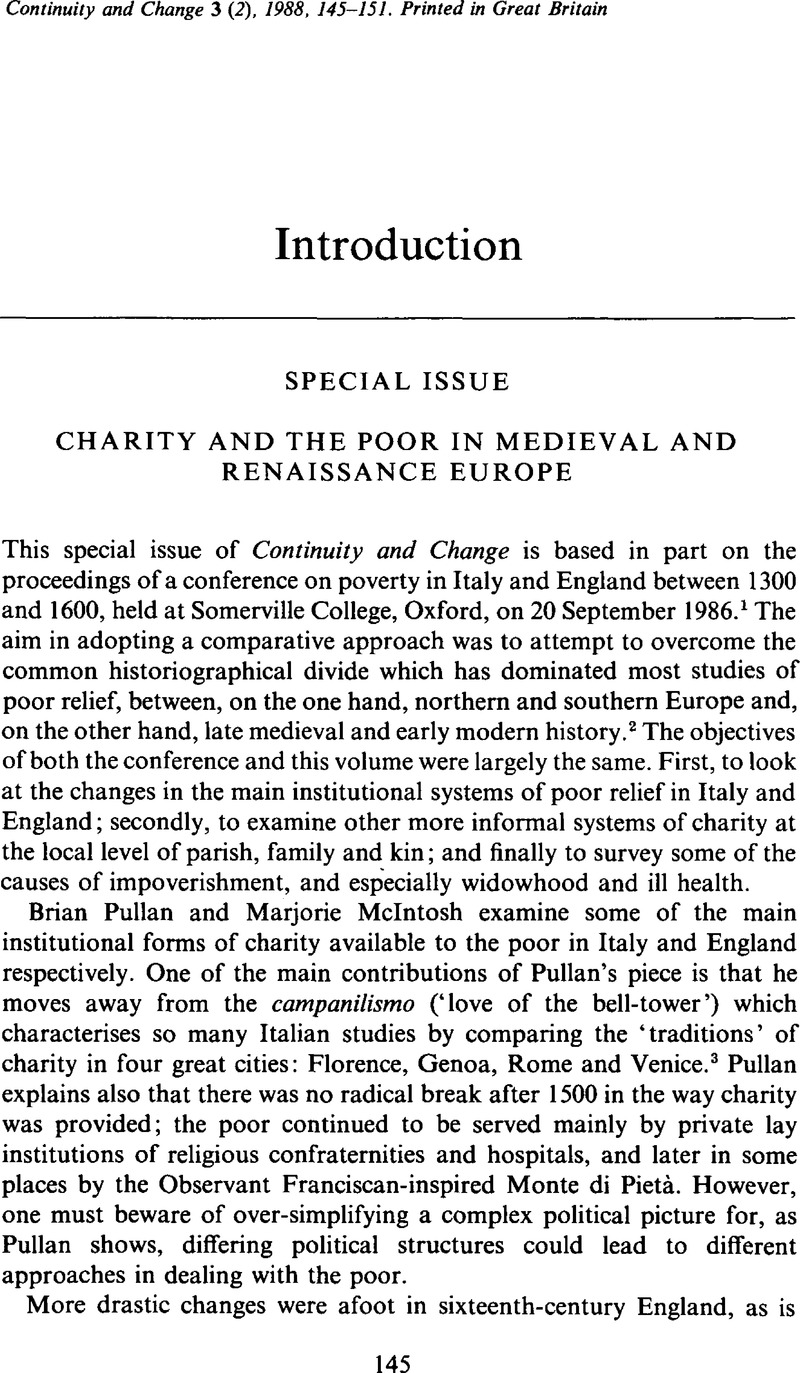No CrossRef data available.
Article contents
Abstract

- Type
- Introduction
- Information
- Continuity and Change , Volume 3 , Special Issue 2: SPECIAL ISSUE: CHARITY AND THE POOR IN MEDIEVAL AND RENAISSANCE EUROPE , August 1988 , pp. 145 - 151
- Copyright
- Copyright © Cambridge University Press 1988
References
ENDNOTES
1 I am most grateful to Barbara Harvey of Somerville College, Oxford, for her enthusiasm and efficiency in co-organising the conference, and to the Wellcome Trust and the History Faculty, University of Oxford, for their generous financial support.
2 The main exceptions are Lis, C., Soly, H., Poverty and capitalism in pre-industrial Europe (Sussex, 1979)Google Scholar; Geremek, B., Mendicanti e miserabili nell' Europa moderna (1350–1600) (Paris, 1980)Google Scholar, and La pietà e la forca. Storia della miseria e della carità in Europa (Rome, Bari, 1986)Google Scholar; and the collection of essays in Riis, T.., ed., Aspects of poverty in early modern Europe (Stuttgart, 1981).Google Scholar
3 See also Pullan's survey article ‘Poveri, mendicanti e vagabondi (secoli XIV–XVII)’, in Storia d' Italia, Annali I. Dal feudalismo al capitalismo (Turin, 1978), 981–1047Google Scholar; and in the same volume: Woolf, S. J., ‘La formazione del proletariate’ (sec. XVIII-XIX) 1049–78Google Scholar; Politi, G., Rosa, M., Peruta, F. della, eds., Timore e carità. I poveri nell' Italia moderna. Atti del convegno ‘Pauperismo e assistenza negli antichi stati italiani’ (Cremona, 28–30 marzo 1980), (Cremona, 1982).Google Scholar
4 The standard work on English poor relief in this period is now: Slack, P., Poverty and policy in Tudor and Stuart England (London, 1988).Google Scholar
5 For the role of the parish at the local level in seventeenth-century England see Wales, T., ‘Poverty, poor relief and the life-cycle: some evidence from seventeenth-century Norfolk’, in the important volume of essays: Smith, R. M., ed., Land, kinship and life-cycle (Cambridge, 1984) 386–87.Google Scholar
6 See, though, Romano, D., ‘Charity and community in early renaissance Venice’, Journal of urban history 11 (1984) 63–81CrossRefGoogle Scholar, and , D. V. and Kent, F. W., Neighbours and neighbourhood in renaissance Florence. The district of the red lion in the fifteenth century (New York, 1982) 132Google Scholar. See also Cohn 's, S. K. Jr study of social relations within the Florentine parish in his book: The laboring classes in renaissance Florence (New York, London, 1980).Google Scholar
7 Cf. Barron, C. M., ‘The parish fraternities of medieval London’, in Barron, C. M., Harper-Bill, C., eds., Essays in honour of F. R. H. Du Boulay (Suffolk, 1985) 13–37Google Scholar, and Henderson, J., ‘Confraternities and the church in late-medieval Florence’, Studies in church history 23 (1986) 69–83.CrossRefGoogle Scholar
8 This has been one of the themes of the research project, entitled ‘Work and family in pre-industrial Europe’, organised by C. Poni and S. J. Woolf at the European University Institute, Florence.
9 On Florence see: Spicciani, A., ‘The “poveri vergognosi” in fifteenth-century Florence. The first 30 years' activity of the Buonomini di S. Martino’, Riis, , ed., Aspects of Poverty, 119–82Google Scholar, and Woolf, S. J., The poor in western Europe in the eighteenth and nineteenth centuries (London, 1986) ch. 7Google Scholar; on England: Smith, R. M., ‘Some issues concerning families and their property in rural England 1250–1800’, in Smith, , ed., Land, kinship and life-cycle, 74–77Google Scholar, and Wales, ‘Poverty, poor relief’, in Ibid., 351–404.
10 See also Klapisch-Zuber, C., Women, family and ritual in renaissance Italy (Chicago, 1985) 117–31Google Scholar, and Kuehn, T., ‘Some ambiguities of female inheritance ideology in the renaissance’, Continuity and change 2, 11–36.CrossRefGoogle Scholar
11 On women's employment see Herlihy, D., Klapisch-Zuber, C., Tuscans and their families. A study of the Florentine Catasto of 1427 (New Haven, London, 1985), 124Google Scholar; Klapisch-Zuber, Women, family and ritual, ch. 8; Brown, J. C., Goodman, J., ‘Women and industry in Florence’, The Journal of Economic History 40 (1980), 73–80CrossRefGoogle Scholar. Some recent work on England includes Goldberg, P. J. P., ‘Female labour, service, and marriage in the late medieval urban north’, Northern History, 22 (1986), 18–38CrossRefGoogle Scholar; and Holderness, B. A., ‘Widows in pre-industrial society: an essay upon their economic functions’, in Smith, R. M., ed., Land, kinship and life-cycle, 423–42.Google Scholar
12 For Italy see Pullan's paper above, and for England: Slack, Poverty and policy.
13 This was not simply moral corruption, but also the ‘corruption’ produced by disease which infected the air. See, for example, the reactions in the early 1520s of Cardinal Giulio de' Medici in Florence and the Health Board of Venice: Richa, G., Notizie istoriche delle chiese fiorentine, divise ne' suoi quartieri (Florence, 1754–1762), 7, 319Google Scholar, and Corradi, A., ‘Nuovi documenti per la storia delle malattie veneree in Italia dalla fine del quattrocento alia meta del cinquecento’, Annali universali di medicina e chirugia 269 (1884) 379.Google Scholar
14 Milan and Venice, for example: Albini, G., Guerra, fame, peste. Crisi di mortalità e sistema sanitario nella Lombardia tardomedioevale (Bologna, 1982) 85–7Google Scholar; Pullan, B., ‘The famine in Venice and the new poor law, 1527–1529’, Bollettino dell' istituto di storia della società e dello stato Veneziano, 5–6 (1963–1964), 173–74.Google Scholar
15 As suggested in my paper in this volume. For England see the Introduction to Dendy, F. W., ed., Extracts from the records of the company of hostmen of Newcastle-upon-Tyne, Publications of the Surtees Society 105 (1901)Google Scholar, and for institutional-community relations see Cavallo, S., ‘Strategic politiche e familiari intorno al baliatico. Il monopolio dei bambini abbandonati nel Canavese tra Sei e Settecento’, Quaderni storici, 18 (1983) 391–420.Google Scholar
16 See the study for early nineteenth-century Florence by Woolf, The poor in western Europe, ch. 7.
17 Klapisch-Zuber, Herlihy, Tuscans and their families, 292Google Scholar; Table 10.1.
18 See Clark, E., ‘Some aspects of social security in medieval England’, Journal of Family History 7 (1982) 307–20CrossRefGoogle Scholar; Smith, R. M., ‘The structured dependence of the elderly as a recent development: some skeptical historical thoughts’, Ageing and society 4 (1984) 409–428.CrossRefGoogle Scholar




